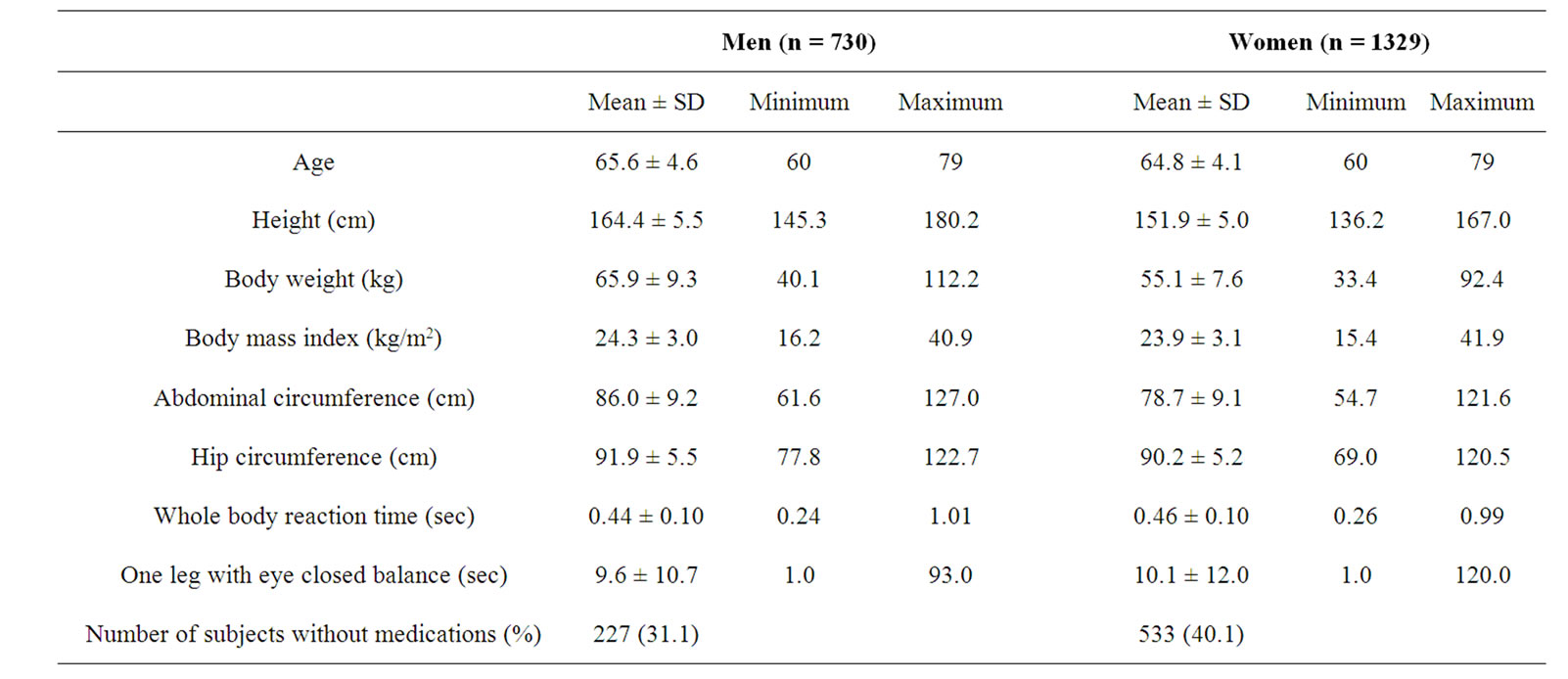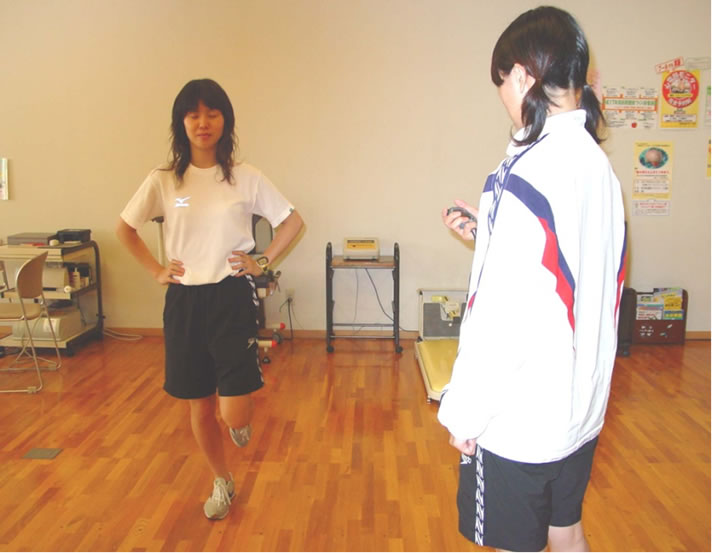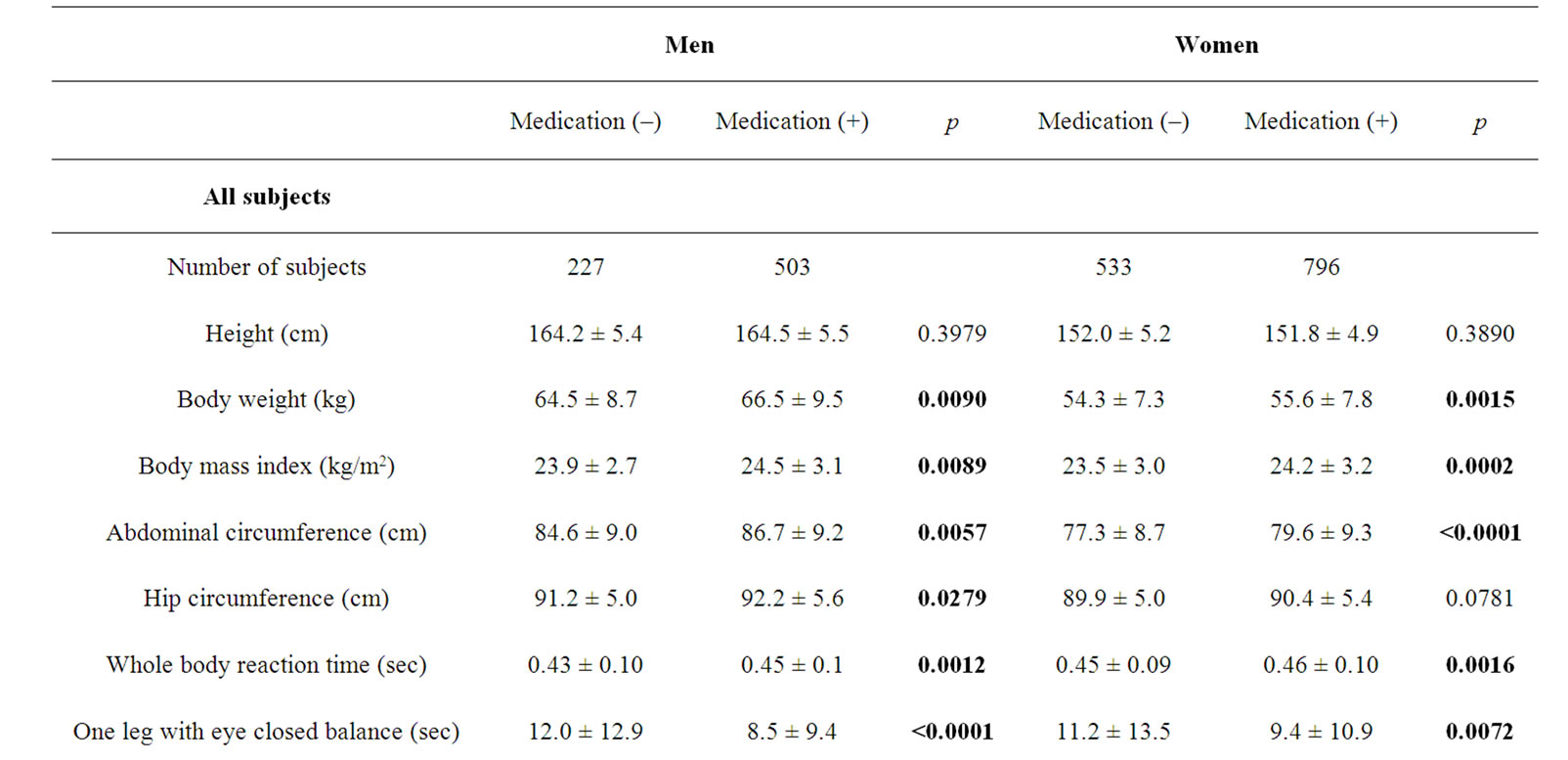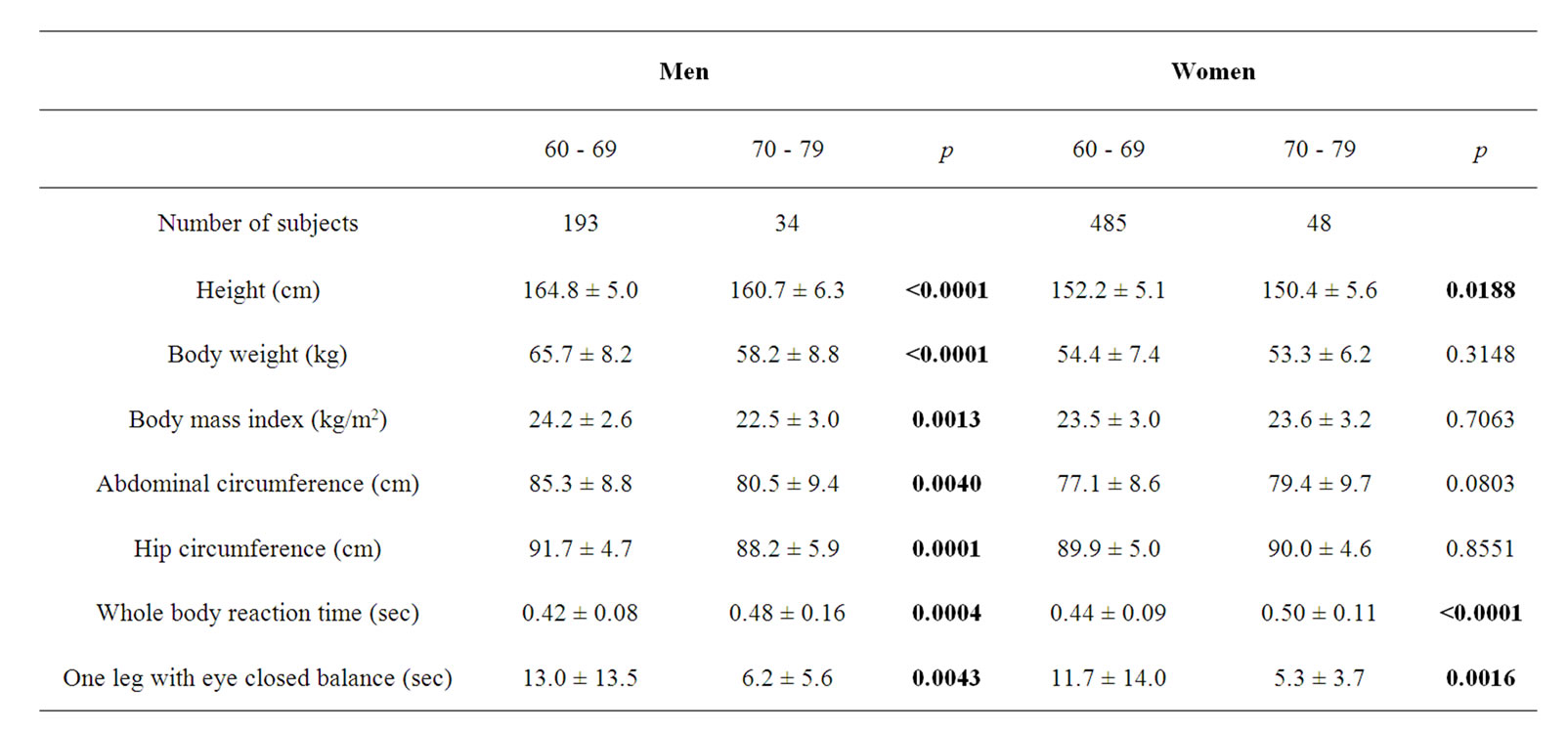Open Journal of Epidemiology
Vol.2 No.1(2012), Article ID:17238,6 pages DOI:10.4236/ojepi.2012.21004
Evaluation of whole body reaction time and one leg with eye closed balance in elderly Japanese*
![]()
1Department of Hygiene, Faculty of Medicine, Kagawa University, Miki, Japan
2Department of Public Health, Faculty of Medicine, Kagawa University, Miki, Japan
3Okayama Southern Institute of Health, Okayama Health Foundation, Okayama, Japan
Email: miyarin@med.kagawa-u.ac.jp
Received 28 November 2011; revised 19 January 2012; accepted 27 January 2012
Keywords: Elderly Japanese; Whole Body Reaction Time; One Leg with Eye Closed Balance
ABSTRACT
We evaluated whole body reaction time and one leg with eye closed balance in elderly Japanese. A total of 2059 elderly Japanese (730 men and 1329 women), aged 60 - 79 years, were enrolled in the cross-sectional investigation study. Anthropometric parameters, whole body reaction time and one leg with eye closed balance were measured. Whole body reaction time was significantly higher and one leg with eye closed balance was significantly lower in 70’s than those in 60’s in both sexes. Two hundred twenty seven men (31.1%) and 533 women (40.1%) were having no medications. In men, whole body reaction time was significantly higher and one leg with eye closed balance was significantly lower in subjects with medications than those in subjects without in 60’s. However, significant differences of whole body reaction time and one leg with eye closed balance between subjects with and without medications in men with 70’s and women with 60’s and 70’s were not noted. This standard mean value may provide a useful reference database for evaluating whole body reaction time and one leg with eye closed balance in Japanese elderly subjects.
1. INTRODUCTION
Rate of elderly subjects (over 65 years) in Japan are dramatically increased and has become public health challenge in Japan. For example, 28,216,000 subjects (22.1%) are reported to be over 65 years old in Japan [1].
It has been shown that obese subjects have a high mortality rate [2] and have linked to atherogenic risk factors, such as hypertension, coronary heart disease, diabetes mellitus and dyslipidemia [3]. In addition, physical fitness was a graded, independent, long-term predictor of mortality from cardiovascular causes in healthy, middle-aged men [4]. Lower and declining muscle strength was also associated with increased mortality, independent of physical activity and muscle mass [5]. We have previously showed that anthropometric parameters, muscle strength, flexibility and aerobic exercise level in elderly Japanese. Especially in elderly subjects without medications, this standard mean value in 60’s and 70’s may provide a useful database for evaluating anthropometric parameters and physical fitness [6]. However, according to other physical fitness i.e. agility and balance, there are few studies that focused on reductions in mortality or the prevention of lifestyle-related diseases, and the optimal level was not defined. Therefore, evaluation of agility i.e. whole body reaction time and balance i.e. one leg with eye closed balance still remains to be investigated in elderly Japanese without medications.
In this study, we evaluated whole body reaction time and one leg with eye closed balance in elderly Japanese and compared those parameters between subjects with and without medications.
2. SUBJECTS AND METHODS
2.1. Subjects
A total of 2059 elderly subjects (730 men and 1329 women), aged 60 - 79 years, was enrolled in this cross-sectional investigation study. All subjects met the following criteria: 1) they had been wanting to change their lifestyle i.e., diet and exercise habits, and had received an annual health checkup from June 1997 to Dec 2009 at Okayama Southern Institute of Health; 2) their anthropometric, whole body reaction time and one leg with eye closed balance measurements had been taken as part of their annual health checkups; and 3) they provided written informed consent (Table 1).
The study was approved by the Ethics Committee of Okayama Health Foundation.

Table 1. Clinical profiles of enrolled subjects.
2.2. Anthropometric Measurements
The anthropometric parameters were evaluated by using the following respective parameters such as height, body weight, body mass index (BMI), abdominal circumference and hip circumference. BMI was calculated by weight/[height]2 (kg/m2). The abdominal circumference was measured at the umbilical level and the hip was measured at the widest circumference over the trochanter in standing subjects after normal expiration [7].
2.3. Whole Body Reaction Time
Whole body reaction time was measured by using THP- 15 (Sakai, Tokyo, Japan) (Figure 1) as follows. Subjects stood still with a posture to be able to change immediately and concentrated attention on a red lamp. When the subjects watch the lamp shined, they jumped as early as possible. Average second of five trials that both legs completely left from a floor was employed to be whole body reaction time [8].
2.4. One Leg with Eye Closed Balance
The examiner first asks the subjects to decide on which leg they would like to stand. The subjects are then asked to stand initially in a relaxed stance with their weight evenly distributed between both. With their eyes close, the subjects are instructed to stand on the leg they have selected, without using any assistive device, and keeping their arms by their sides. The test is over after 120s has elapsed, when the stance foot shifts, or when the lifted foot is replaced on the board, whichever occurs first. To prevent falls or injuries, the examiner stands close to the subjects throughout the trial (Figure 2) [9].

Figure 1. Measurements of whole body reaction time photographed at Okayama Southern Institute of Health, Okayama, Japan.

Figure 2. Measurements of one leg with eye closed balance photographed at Okayama Southern Institute of Health, Okayama, Japan.
2.5. Medications
The data on medications were obtained at interviews conducted by well-trained medical staff using the structured method. The subjects were asked if they currently take medications i.e diabetes, hypertension, dyslipidemia and/ or orthopedic diseases. When the answer was “yes”, they were classified as subjects with medications. When the answer was “no”, they were classified as subjects without medications.
2.6. Statistical Analysis
Data are expressed as means ± standard deviation (SD) values. A comparison of parameters between the 2 groups was made using the unpaired t-test: p < 0.05 was considered to be statistically significant.
3. RESULTS
Clinical profiles are summarized in Table 1. Twenty hundred and twenty seven men (31.1%) and 533 women (40.1%) were take no medications.
We compared the clinical parameters between subjects 60’s and 70’s (Table 2). In men, height, body weight, BMI and hip circumference in 60’s were significantly higher than those in 70’s. However, abdominal circumference in 60’s was similar to that in 70’s. In women, height was significantly higher and abdominal circumference was significantly lower in 60’s than those in 70’s. Whole body reaction time was significantly lower and one leg with eye closed balance was significantly higher in 60’s than those in 70’s in both sexes.
We further analyzed clinical parameters between subjects with and without medications (Table 3). There were significant differences of anthropometric parameters (except height), whole body reaction time and one leg with eye closed balance between men with and without medications. In women, there were also significant differences of anthropometric parameters (except height and hip circumference), whole body reaction time and one leg with eye closed balance between subjects with and without medications.
In addition, in 60’s, significant differences of whole body reaction time and one leg with eye closed balance between men with and without medications, and body weight, BMI, abdominal circumference and hip circumference between women with and without medications were noted. In 70’s, anthropometric parameters were significantly higher in men with medications than those in men without medications. There were not significant differences of other parameters between subjects with and without medications (Table 3).
We found that there were significant differences of some parameters between subjects with and without medications. We finally compared parameters between 60’s and 70’s in subjects without medications (Table 4). In men, anthropometric parameters and one leg with eye closed balance were significantly lower and whole body reaction time was significantly higher in 70’s than those in 60’s. In women, whole body reaction time was significantly higher, height and one leg with eye closed balance were significantly lower in 70’s than those in 60’s. There were no differences of other parameters between 60’s and 70’s in subjects without medications.

Table 2. Comparison of clinical parameters in all subjects.



Table 3. Comparison of clinical parameters between subjects with and without medications as classified by age groups.

Table 4. Comparison of clinical parameters in subjects without medications.
4. DISCUSSION
We evaluated whole body reaction time and one leg with eye closed balance in elderly Japanese. Especially in elderly subjects without medications, this standard mean value in 60’s and 70’s may provide a useful reference database for evaluating whole body reaction time and one leg with eye closed balance.
For preventing life-style related diseases, the level of maximal oxygen uptake and muscle strength was recommended in exercise and physical activity reference quantity for health promotion 2006 (EPARQ2006) by ministry of health, labor and welfare of Japan. However, according to other physical fitness i.e. agility and balance, the optimal level was not defined [10]. Reaction time is a physiological entity that has been linked as a causal factor in the incidence of falls in the elderly population [11]. In some literatures, whole body reaction time was analyzed in elderly Japanese. Higuchi et al. have reported that the whole body reaction time was increased with aging over 50’s by 1028 Japanese, aged 20 - 85 years [12]. Cao et al. have reported that the effect of a 12-week combined exercise intervention program on physical performance and gait kinematics in community dwelling elderly women (n = 20). They showed that the whole body reaction time significantly decreased from 0.48 ± 0.07 sec to 0.45 ± 0.07 sec (6.4%) after intervention [11]. In addition, they also explored the effect of 12-month exercise and nutritional intervention by voluntary, homebased exercise [13].
According to one leg with eye closed balance, reference value for one leg balance time in elderly subjects varied widely from study to study [9], because various procedure are used to carry out the test i.e. eye-opened and eye-closed. At present, there is no consensus on whether it is better to perform the test with the eye open or closed. Potvin et al. reported and concluded that the test was more effective with the eyes closed [14]. The mean reported one leg balance time of women aged 70 - 79 years ranging widely by as much as 6.9 - 32.9 sec [15].
In this study, we measured 730 men and 1329 women over the age of 60. In addition, we compared parameters between subjects with and without medications. This information gathered may serve as a useful reference database for evaluating whole body reaction time and one leg with eye closed balance in elderly Japanese.
Potential limitations remain in this study. First, our study was a cross sectional and not a longitudinal study. In addition, although there were differences of height or weight between 60’s and 70’s, cross sectional study design and/or difference of the birth cohort may affect these results. These greatly decrease the validity of the study. Second, the 2059 elderly subjects, all of whom wanted to change their lifestyle, underwent measurements for this study at Okayama Southern Institute of Health: they were therefore more health-conscious than the average person, especially may be in 70’s. Thus, this study has a big selection bias. Third, the small sample size in especially 70’s without medications might make it difficult to compare whole body reaction time and one leg with eye closed balance between subjects with and without medications. Therefore, this study does not have enough participants to obtain the standard mean value for the Japanese population. Further prospective, large sample size and community based studies are urgently needed in elderly Japanese.
5. ACKNOWLEDGEMENTS
This research was supported in part by Research Grants from the Ministry of Health, Labor, and Welfare, Japan.
REFERENCES
- Health and Welfare Statistics Association (2009) Journal of Health and Welfare Statistics, 56, 39 (in Japanese).
- Sjostrom, L.V. (1992) Mortality of severely obese subjects. The American Journal of Clinical Nutrition, 55, 516S-523S.
- Pouliot, M.C., Despres, J.P., Nadeeau, A., Moorjani, S., Prud’sHomme, D., Lupien, P.J. and Tremblay, A. (1992) Visceral obesity in men. Associations with glucose tolerance, plasma insulin, and lipoprotein levels. Diabetes, 41, 826-834. doi:10.2337/diabetes.41.7.826
- Sandvik, L., Erikssen, J., Thaulow, E., Erikssen, G., Mundal, R. and Rodahl, K. (1993) Physical fitness as a predictor of mortality among healthy, middle-aged Norwegian men. The New England Journal of Medicine, 25, 533-537. doi:10.1056/NEJM199302253280803
- Metter, E.J., Talbot, L.A., Schrager, M. and Conwit, R. (2002) Skeletal muscle strength as a predictor of all-cause mortality in healthy men. The Journals of Gerontology Series A, 57, B359-B365. doi:10.1093/gerona/57.10.B359
- Miyatake, N., Miyachi, M., Tabata, I. and Numata, T. (2011) Evaluation of anthropometric parameters and physical fitness in elderly Japanese. Environmental Health and Preventive Medicine, 17, 62-68.
- [No authors listed] (2005) Definition and the diagnostic standard for metabolic syndrome—Committee to evaluate diagnostic standards for metabolic syndrome. Nippon Naika Gakkai Zasshi, 94, 794-809. doi:10.2169/naika.94.794
- Miyatake, N., Miyachi, M., Nishikawa, H., Saito, T. and Numata, T. (2007) Comparison of whole body reaction time between Japanese men with and without metabolic syndrome. International Journal of Sport and Health Sciences, 5, 122-124. doi:10.5432/ijshs.5.122
- Michikawa, T., Nishiwaki, Y., Takebayashi, T. and Toyama, Y. (2009) One-leg standing test for elderly populations. Journal of Orthopaedic Science, 14, 675-685. doi:10.1007/s00776-009-1371-6
- National Institute of Health and Nutrition, Japan (2011). http://www.nih.go.jp/eiken/programs/pdf/epar2006.pdf
- Cao, Z.B., Maeda, A., Shima, N., Kurata, H. and Nishizono, H. (2007) The effect of a 12-week combined exercise intervention program on physical performance and gait kinematics in community-dwelling elderly women. Journal of Physiological Anthropology, 26, 325-332. doi:10.2114/jpa2.26.325
- Higuchi, M., Okada, A., Hisamoto, S. and Miyano, M. (2008) Study of the results of measurements of Japanese physical fitness. Japanese Journal of Physiological Anthropology, 13, 115-124 (in Japanese).
- Cao, Z.B., Tabata, I. and Nishizono, H. (2009) Good maintenance of physical benefits in a 12-month exercise and nutritional intervention by voluntary, home-based exercise: A 6-month follow-up of a randomized controlled trial. Journal of Bone and Mineral Metabolism, 27, 182-189. doi:10.1007/s00774-008-0022-x
- Potvin, A.R., Syndulko, K., Tourtellotte, W.W., Lemmon, J.A. and Potvin, J.H. (1980) Human neurologic function and the aging process. Journal of American Geriatrics Society, 28, 1-9.
- Rudisill, M.E. and Toole, T. (1993) Gender differences in motor performance of 50- to 79-year-old adults. Perceptual and Motor Skills, 77, 939-947. doi:10.2466/pms.1993.77.3.939
NOTES
*There is no conflict of interest.

